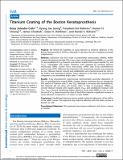| dc.contributor.author | Jeong, Kyung Jae | |
| dc.contributor.author | Kolovou, Paraskevi Evi | |
| dc.contributor.author | Chodosh, James | |
| dc.contributor.author | Dohlman, Claes H. | |
| dc.contributor.author | Kohane, Daniel S. | |
| dc.contributor.author | Chiang, Homer H. | |
| dc.contributor.author | Salvador Culla, Borja | |
| dc.date.accessioned | 2016-11-17T23:31:43Z | |
| dc.date.available | 2016-11-17T23:31:43Z | |
| dc.date.issued | 2016-04 | |
| dc.date.submitted | 2015-09 | |
| dc.identifier.issn | 2164-2591 | |
| dc.identifier.uri | http://hdl.handle.net/1721.1/105353 | |
| dc.description.abstract | Purpose: We tested the feasibility of using titanium to enhance adhesion of the Boston Keratoprosthesis (B-KPro), ultimately to decrease the risk of implant-associated complications. Methods: Cylindrical rods were made of poly(methyl methacrylate) (PMMA), PMMA coated with titanium dioxide (TiO[subscript 2]) over a layer of polydopamine (PMMA[subscript TiO2]), smooth (Ti) and sandblasted (Ti[subscript SB]) titanium, and titanium treated with oxygen plasma (Ti[subscript ox] and Ti[subscript SBox]). Topography and surface chemistry were analyzed by scanning electron microscopy (SEM), atomic force microscopy (AFM), and X-ray photoelectron spectroscopy (XPS). Adhesion force between rods and porcine corneas was measured ex vivo. Titanium sleeves, smooth and sandblasted, were inserted around the stem of the B-KPro and implanted in rabbits. Tissue adhesion to the stem was assessed and compared to an unmodified B-Kpro after 1 month. Results: X-ray photoelectron spectroscopy demonstrated successful deposition of TiO[subscript 2] on polydopamine-coated PMMA. Oxygen plasma treatment did not change the
XPS spectra of titanium rods (Ti and Ti[subscript SB]), although it increased their hydrophilicity. The materials did not show cell toxicity. After 14 days of incubation, PMMA[subscript TiO2], smooth titanium treated with oxygen plasma (Ti[subscript ox]), and sandblasted titanium rods (Ti[subscript SB], Ti[subscript SBox]) showed significantly higher adhesion forces than PMMA ex vivo. In vivo, the use of a Ti[subscript SB] sleeve around the stem of the B-KPro induced a significant increase in tissue adhesion compared to a Ti sleeve or bare PMMA. Conclusions: Sandblasted titanium sleeves greatly enhanced adherence of the B-KPro to the rabbit cornea. This approach may improve adhesion with the donor cornea in humans as well. Translational Relevance: This approach may improve adhesion with donor corneas in humans. | en_US |
| dc.description.sponsorship | Massachusetts Eye and Ear Infirmary. Keratoprosthesis Fund | en_US |
| dc.language.iso | en_US | |
| dc.publisher | Association for Research in Vision and Ophthalmology | en_US |
| dc.relation.isversionof | http://dx.doi.org/10.1167/tvst.5.2.17 | en_US |
| dc.rights | Creative Commons Attribution-NonCommercial-NoDerivs License | en_US |
| dc.rights.uri | http://creativecommons.org/licenses/by-nc-nd/4.0/ | en_US |
| dc.source | Association for Research in Vision and Ophthalmology (ARVO) | en_US |
| dc.title | Titanium Coating of the Boston Keratoprosthesis | en_US |
| dc.type | Article | en_US |
| dc.identifier.citation | Salvador-Culla, Borja et al. “Titanium Coating of the Boston Keratoprosthesis.” Translational Vision Science & Technology 5.2 (2016): 17. © 2015 Association for Research in Vision and Ophthalmology | en_US |
| dc.contributor.department | Koch Institute for Integrative Cancer Research at MIT | en_US |
| dc.contributor.mitauthor | Chiang, Homer H. | |
| dc.contributor.mitauthor | Salvador Culla, Borja | |
| dc.relation.journal | Translational Vision Science & Technology | en_US |
| dc.eprint.version | Final published version | en_US |
| dc.type.uri | http://purl.org/eprint/type/JournalArticle | en_US |
| eprint.status | http://purl.org/eprint/status/PeerReviewed | en_US |
| dspace.orderedauthors | Salvador-Culla, Borja; Jeong, Kyung Jae; Kolovou, Paraskevi Evi; Chiang, Homer H.; Chodosh, James; Dohlman, Claes H.; Kohane, Daniel S. | en_US |
| dspace.embargo.terms | N | en_US |
| mit.license | PUBLISHER_CC | en_US |
